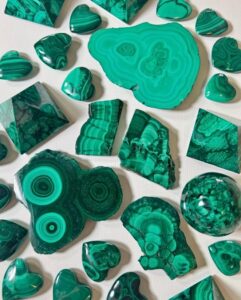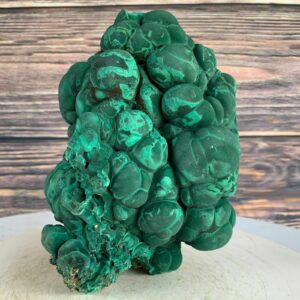Malachite is a very popular stone because of its bright, deep green color and banding. Add in a nicely polished cabochon or free-form polished piece and you have the ingredients for a great piece to add to your rock collection. At most rock and mineral shows you’ll see beads, cabs, pyramids, and carved animals made from malachite.
It’s not uncommon to find other minerals present with malachite and this makes for some unique specimens and cabochons. Azurite, turquoise, and chrysocolla are common minerals found next to malachite due to the copper baring nature of the minerals.
How to Identify Malachite Through Testing
There are various ways to identify rocks, minerals, crystals, and gemstones, but we will use a method I learned while attending the Gemological Institute of America. If you’ve learned a unique way to identify gems, please share it with us.
If you need help valuing and pricing Malachite then use my free guide.
Let’s take a deeper look into how to identify Malachite like a pro.

Visual Inspection
The visual inspection starts with what form of Malachite you have. The questions below are relatively easy to answer, but each type will have its own process for identifying them.

Is it a cabochon? If you’re dealing with a cabochon, it should have a medium to high polish with some pitting on the surface. Malachite will display banded shades of green as well as tree ring-looking bands. Sizes and shapes of cabochons will vary but don’t be fooled by imitation malachite. There are companies taking malachite dust and azurite dust and compressing them into blocks. Lapidary artists craft jewelry from these blocks of pressed material.
The good news is, they’re fairly easy to spot because they lack banding in the green areas. You’ll see green blotches on top of a rich blue backdrop.
Is it faceted? This would be very uncommon and I don’t believe I’ve seen a faceted piece before.

Is it a specimen? Malachite is found in different forms and is a very common green mineral. You’ll get better at identifying these forms by looking at and inspecting this mineral over time. Here’s a list of characteristics Malachite displays when it’s a specimen.
- Non-crystalline specimens are opaque, with a dull to earthy luster.
- You’ll be able to do the streak test; keep reading below if you have a rough piece with no commercial value. Look for the green streak.
- They’re usually in an acicular to tabular shape if found in crystal form.
- Malachite is rarely found in crystal form.
Is it tumbled? Very common to find tumbled Malachite. Again, beautiful blended green banding, high polish, and little pitting.
Physical Properties of Malachite
Let’s take a look at the physical properties of Malachite. Knowing what to look for will help you more easily identify what you’re looking at.
Color: Green
Clarity / Transparency: Opaque
Luster: Fibrous Specimens – Silky, Rare Crystals – Vitreous to Adamantine, Massive Specimens – Dull to Earthy, Polishes to a Bright Lister
Cleavage: Perfect in one direction, Fair in a second
Fracture: Subconchoidal to Uneven
The Streak Test
This is a destructive test, so you need to ensure that you’re allowed to damage the specimen or stone if you choose to use this method. Once you’ve developed robust knowledge in identifying rocks and minerals, you won’t be using destructive tests.
A mineral streak test is when you scrape the stone against a harder surface to see what color remains. Malachite has a light greenish streak.
Raw Malachite can be streaked across a piece of white paper to expose its color; malachites are always light green.
Tumbled specimens are tested by scraping a specimen across a piece of ungalvanized porcelain, typically known as a streak plate.
If you conduct a streak test with what you think is Malachite, but the streak shows anything but green, you do not have the believed specimen.
Magnet Test
Malachite is not magnetic, so it shouldn’t respond to common magnets. However, there are exceptions to the magnet test.
For instance, it’s entirely normal for Malachite to contain a considerable amount of magnetite. Since iron ore minerals are formed similarly, the two types may have combined during their chemical formation process. When this occurs, the chemical composition of Malachite changes, making the Malachite weakly attracted to magnets.
As a result, it’s possible to mistake a Malachite specimen for either pyrrhotite or magnetite. That said, this is why we should consider utilizing all of the identification marks before ruling anything out.
Hardness Test
I don’t recommend actively testing the hardness of a stone because it’s destructive in nature and doesn’t really provide a definite answer to what type of stone it is. With that being said, Malachite has a hardness of 3.5 to 4 on the Mohs hardness scale.
Refractive Index Test
Determining the refractive index, or RI as it’s referred to by gemologists, for Malachite is relatively straightforward, but you’ll need a specific piece of test equipment and the RI fluid to go with it. Before you place the stone on the refractometer, you want to make sure you have a flat, somewhat polished surface to take a reading.
Malachite’s Refractive Index: 1.65 to 1.91
Each gemstone has its own RI, so discovering a sample’s RI can help you figure out what sort of stone it actually is.
Step 1 – Place a small bead of RI fluid on the metal surface of the refractometer near the back of the crystal hemicylinder (the window on which the stone will sit).
Step 2 – Place the stone facet face down on the fluid dot and slide it toward the middle of the hemicylinder crystal using your fingers.
Step 3 – Look through the viewer lens without magnification. Continue looking until you see the outline of a bubble, then look at the bottom of this bubble. Take the reading from there, rounding the decimal to the nearest hundredth.
Occasionally, you’ll run into the issue of not having a flat surface to work with. In this instance, you’ll need to leave the top of the refractometer open and hold the rounded stone with your hand. Hopefully, you’ll be able to pull a reading off of the gauge.
Birefringence Test
You won’t be using this test for Malachite, but I wanted to include this test just in case you were considering it in your process.
Consider testing the birefringence, as well. Birefringence is related to RI. While doing the birefringence test, you will turn the gemstone on the refractometer six times throughout the observation period and note the changes.
Perform a standard RI test. Instead of keeping the stone still, gradually turn it 180 degrees, making each separate turn about 30 degrees. At each 30-degree mark, take a new RI reading.
Subtract the lowest reading from the highest to find the stone’s birefringence. Round it to the nearest thousandth.
Birefringence: δ = 0.254
Single or Double Refraction
Malachite has a double refraction.
For this test to be accurate and beneficial, the stone needs to be transparent in nature. If the light won’t pass through the stone, then there is no way to test for single or double refraction.
Check for single or double refraction. Use this test on translucent and transparent stones. You can determine whether the stone is only singly refractive (SR) or doubly refractive (DR) to help identify it. Some stones can also be classified as aggregate (AGG).
Turn on the light of a polariscope and place the stone face down on the lower glass lens (polarizer). Look through the top lens (analyzer), turning the top lens until the area around the stone looks darkest. This is your starting point.
Turn the analyzer 360 degrees and watch how the light around the stone changes.
If the stone appears dark and stays dark, it is likely an SR. If the stone starts light and stays light, it is likely AGG. If the lightness or darkness of the stone changes, it is likely DR.
Checking The Diaphaneity
Diaphaneity refers to the mineral’s ability to transmit light. For instance, some minerals are transparent or translucent. When they’re thick, a small amount of distortion might occur, but light will pass through them relatively freely.
Malachite is opaque. However, its translucency depends on the form it has taken. For instance, Malachite crystals are translucent.
Finding The Specific Gravity
Every stone has its unique specific gravity, which helps us identify them. Specific gravity is one of the best properties to measure when identifying mineral specimens. Most minerals have a narrow range of specific gravity, so getting an accurate measurement can go a long way toward identification.
Specific gravity is a unitless number describing how heavy a mineral is compared to equal volumes of water. For example, if a mineral is three times as dense as water, it’ll have a specific gravity of three. This is useful because while two minerals might be the same size, they’ll each have a different specific gravity.
The larger the sample, the more precise the readings tend to be. Remember that this technique can only be used for single mineral or crystal masses. It will not work for minerals embedded in host rocks.
Malachite’s Specific Gravity: 3.6 – 4.0
As helpful as specific gravity is for identifying minerals, amateurs are usually constrained by the lack of necessary tools for the job. However, one way to work around this is to hold the specimen and note how heavy or heft it feels compared to what you might expect a specimen of that size to weigh.
If you want to determine the specific gravity of your stone like a pro, you’ll need to invest in a higher-end scale. This is the one gemologists use OHAUS Density Determination Kit.
.Identifying Rocks and Minerals Like a Pro
Hopefully, you feel confident in your practice to identify a piece of Malachite after reading and applying this guide. You’ll be using the visual part of this guide the most, and you’ll get better as you interact with more gemstones. Before you know it, you’ll be identifying stones like a gemologist.
If you run into any issues or get confused, feel free to reach out. I’ll do my best to assist you in the identification process.
- Identify Enstatite - March 12, 2024
- Identify Cerussite - March 3, 2024
- Identify Bytownite - February 18, 2024
